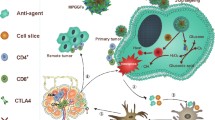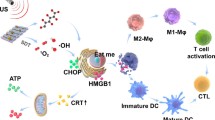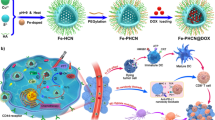Abstract
Immunotherapy brings new hope for tumor treatment by inducing immunogenic cell death (ICD) of tumor cells. However, insufficient immunogenicity and low immune response rate greatly limit antitumor immunity. Herein, by optimizing the composition and morphology, the rational design of Janus nanoparticles composed of Fe3O4 nanospheres and SiO2 nanorods was realized for enhanced cancer immunotherapy through amplified ICD. After glucose oxidase (GOx) was loaded by the Janus nanoparticles, the resultant M-FS-GOx consumes glucose at tumor sites to generate gluconic acid and hydrogen peroxide (H2O2) for starvation therapy while the H2O2 supply promotes the production of highly toxic ·OH to achieve effective chemodynamic therapy (CDT). Under a 1064 nm light irradiation, the photothermal effect of M-FS-GOx enhances the enzyme activity of GOx for improved starvation therapy. Furthermore, both tumor-associated antigens released during the process of ICD and the intrinsic immunoadjuvant property of M-FS-GOx stimulate dendritic cell maturation to activate antitumor immune responses. This work provides a promising strategy for the construction of Janus nanoparticles to achieve enhanced cancer immunotherapy through combination therapy-amplified ICD.
Similar content being viewed by others
References
Waldman A D, Fritz J M, Lenardo M J. A guide to cancer immunotherapy: From T cell basic science to clinical practice. Nat Rev Immunol, 2020, 20: 651–668
Goldberg M S. Improving cancer immunotherapy through nanotechnology. Nat Rev Cancer, 2019, 19: 587–602
Duan X, Chan C, Lin W. Nanoparticle-mediated immunogenic cell death enables and potentiates cancer immunotherapy. Angew Chem Int Ed, 2019, 58: 670–680
Guo K, Jiao Z, Zhao X, et al. Melanin-based immunoregulatory nanohybrids enhance antitumor immune responses in breast cancer mouse model. ACS Nano, 2023, 17: 10792–10805
Wan J, Zhang X, Tang D, et al. Biodegradable NIR-II pseudo conjugate polymeric nanoparticles amplify photodynamic immunotherapy via alleviation of tumor hypoxia and tumor-associated macrophage reprogramming. Adv Mater, 2023, 35: 2209799
Chen H L, Liu H, Liu L X, et al. Fabrication of subunit nanovaccines by physical interaction. Sci China Tech Sci, 2022, 65: 989–999
Bai Y T, Wang T R, Zhang S L, et al. Recent advances in organic and polymeric carriers for local tumor chemo-immunotherapy. Sci China Tech Sci, 2022, 65: 1011–1028
Zhao X, Guo K, Zhang K, et al. Orchestrated yolk-shell nanohybrids regulate macrophage polarization and dendritic cell maturation for oncotherapy with augmented antitumor immunity. Adv Mater, 2022, 34: 2108263
Chang M, Wang M, Wang M, et al. A multifunctional cascade bioreactor based on hollow-structured Cu2MoS4 for synergetic cancer chemo-dynamic therapy/starvation therapy/phototherapy/immunotherapy with remarkably enhanced efficacy. Adv Mater, 2019, 31: 1905271
Tang Y, Bisoyi H K, Chen X M, et al. Pyroptosis-mediated synergistic photodynamic and photothermal immunotherapy enabled by a tumor-membrane-targeted photosensitive dimer. Adv Mater, 2023, 35: 2300232
Zhao Q, Liang G, Guo B, et al. Polyphotosensitizer-based nanoparticles with Michael addition acceptors inhibiting GST activity and cisplatin deactivation for enhanced chemotherapy and photodynamic immunotherapy. Adv Sci, 2023, 10: 2300175
Li W, Jiang Y, Lu J. Nanotechnology-enabled immunogenic cell death for improved cancer immunotherapy. Int J Pharm, 2023, 634: 122655
Zhao N, Yan L, Xue J, et al. Degradable one-dimensional dextran-iron oxide nanohybrids for MRI-guided synergistic gene/photothermal/magnetolytic therapy. Nano Today, 2021, 38: 101118
Huang X, Teng X, Chen D, et al. The effect of the shape of mesoporous silica nanoparticles on cellular uptake and cell function. Biomaterials, 2010, 31: 438–448
Huang Z, Yao D, Ye Q, et al. Zoledronic acid-gadolinium coordination polymer nanorods for improved tumor radioimmunotherapy by synergetically inducing immunogenic cell death and reprogramming the immunosuppressive microenvironment. ACS Nano, 2021, 15: 8450–8465
Song Z, Fang J, Wang Z, et al. Rod-shaped polymeric nanoparticles intervene neutrophils for efficient ischemic stroke therapy. Adv Funct Mater, 2023, 33: 2212326
Zhang X, Fu Q, Duan H, et al. Janus nanoparticles: From fabrication to (bio)applications. ACS Nano, 2021, 15: 6147–6191
Zhang Y, Huang K, Lin J, et al. Janus nanoparticles in cancer diagnosis, therapy and theranostics. Biomater Sci, 2019, 7: 1262–1275
Wang Z, Zhang F, Shao D, et al. Janus nanobullets combine photodynamic therapy and magnetic hyperthermia to potentiate synergetic anti-metastatic immunotherapy. Adv Sci, 2019, 6: 1901690
Pham T C, Nguyen V N, Choi Y, et al. Recent strategies to develop innovative photosensitizers for enhanced photodynamic therapy. Chem Rev, 2021, 121: 13454–13619
Xu C, Pu K. Second near-infrared photothermal materials for combinational nanotheranostics. Chem Soc Rev, 2021, 50: 1111–1137
Zhao P, Li H, Bu W. A forward vision for chemodynamic therapy: Issues and opportunities. Angew Chem Int Ed, 2023, 62: e202210415
Tang Z, Liu Y, He M, et al. Chemodynamic therapy: Tumour microenvironment-mediated fenton and fenton-like reactions. Angew Chem, 2019, 131: 958–968
Gao S, Lin H, Zhang H, et al. Nanocatalytic tumor therapy by biomimetic dual inorganic nanozyme-catalyzed cascade reaction. Adv Sci, 2019, 6: 1801733
Feng W, Han X, Wang R, et al. Nanocatalysts-augmented and photothermal-enhanced tumor-specific sequential nanocatalytic therapy in both NIR-I and NIR-II biowindows. Adv Mater, 2019, 31: 1805919
Li C, Wan Y, Zhang Y, et al. In situ sprayed starvation/chemodynamic therapeutic gel for post-surgical treatment of iDH1 (R132H) glioma. Adv Mater, 2022, 34: 2103980
Fang C, Deng Z, Cao G, et al. Co-ferrocene MOF/glucose oxidase as cascade nanozyme for effective tumor therapy. Adv Funct Mater, 2020, 30: 1910085
Hu J J, Liu M D, Gao F, et al. Photo-controlled liquid metal nanoparticle-enzyme for starvation/photothermal therapy of tumor by win-win cooperation. Biomaterials, 2019, 217: 119303
Hao Y, Dong Z, Chen M, et al. Near-infrared light and glucose dual-responsive cascading hydroxyl radical generation for in situ gelation and effective breast cancer treatment. Biomaterials, 2020, 228: 119568
Zhou Y, Fan S, Feng L, et al. Manipulating intratumoral fenton chemistry for enhanced chemodynamic and chemodynamic-synergized multimodal therapy. Adv Mater, 2021, 33: 2104223
She D, Peng S, Liu L, et al. Biomimic FeS2 nanodrug with hypothermal photothermal effect by clinical approved NIR-II light for augmented chemodynamic therapy. Chem Eng J, 2020, 400: 125933
Ren H, Yong J, Yang Q, et al. Self-assembled FeS-based cascade bioreactor with enhanced tumor penetration and synergistic treatments to trigger robust cancer immunotherapy. Acta Pharm Sin B, 2021, 11: 3244–3261
Zhang Y, Yang Y, Shi J, et al. A multimodal strategy of Fe3O4@ZIF-8/GOx@MnO2 hybrid nanozyme via TME modulation for tumor therapy. Nanoscale, 2021, 13: 16571–16588
Hu Y, Mignani S, Majoral J P, et al. Construction of iron oxide nanoparticle-based hybrid platforms for tumor imaging and therapy. Chem Soc Rev, 2018, 47: 1874–1900
Gu Z, Liu T, Tang J, et al. Mechanism of iron oxide-induced macrophage activation: The impact of composition and the underlying signaling pathway. J Am Chem Soc, 2019, 141: 6122–6126
Meng J, Zhang P, Chen Q, et al. Two-pronged intracellular co-delivery of antigen and adjuvant for synergistic cancer immunotherapy. Adv Mater, 2022, 34: 2202168
Hong X, Zhong X, Du G, et al. The pore size of mesoporous silica nanoparticles regulates their antigen delivery efficiency. Sci Adv, 2020, 6: eaaz4462
Zhang L, Zhang F, Dong W F, et al. Magnetic-mesoporous Janus nanoparticles. Chem Commun, 2011, 47: 1225–1227
Zhang M K, Li C X, Wang S B, et al. Tumor starvation induced spatiotemporal control over chemotherapy for synergistic therapy. Small, 2018, 14: 1803602
Inaba K, Inaba M, Romani N, et al. Generation of large numbers of dendritic cells from mouse bone marrow cultures supplemented with granulocyte/macrophage colony-stimulating factor. J Exp Med, 1992, 176: 1693–1702
Wang R, Zhao N, Xu F J. Hollow nanostars with photothermal gold caps and their controlled surface functionalization for complementary therapies. Adv Funct Mater, 2017, 27: 1700256
Zhao N, Fan W, Zhao X, et al. Polycation-carbon nanohybrids with superior rough hollow morphology for the NIR-II responsive multimodal therapy. ACS Appl Mater Interfaces, 2020, 12: 11341–11352
Sousa de Almeida M, Susnik E, Drasler B, et al. Understanding nanoparticle endocytosis to improve targeting strategies in nanomedicine. Chem Soc Rev, 2021, 50: 5397–5434
Fu L H, Qi C, Lin J, et al. Catalytic chemistry of glucose oxidase in cancer diagnosis and treatment. Chem Soc Rev, 2018, 47: 6454–6472
Guo Y, Jia H R, Zhang X, et al. A glucose/oxygen-exhausting nanoreactor for starvation- and hypoxia-activated sustainable and cascade chemo-chemodynamic therapy. Small, 2020, 16: 2000897
Wculek S K, Cueto F J, Mujal A M, et al. Dendritic cells in cancer immunology and immunotherapy. Nat Rev Immunol, 2020, 20: 7–24
Abbaraju P L, Meka A K, Song H, et al. Asymmetric silica nanoparticles with tunable head-tail structures enhance hemocompatibility and maturation of immune cells. J Am Chem Soc, 2017, 139: 6321–6328
Liu X Z, Wen Z J, Li Y M, et al. Bioengineered bacterial membrane vesicles with multifunctional nanoparticles as a versatile platform for cancer immunotherapy. ACS Appl Mater Interfaces, 2023, 15: 3744–3759
Author information
Authors and Affiliations
Corresponding authors
Additional information
This work was supported by the National Natural Science Foundation of China (Grant Nos. 52173271, 52221006, and 51922022), Beijing Outstanding Young Scientist Program (Grant No. BJJWZYJH01201910010024), and the Fundamental Research Funds for the Central Universities (Grant No. BHYC1705A).
Rights and permissions
About this article
Cite this article
Chen, B., Guo, K., Wang, H. et al. NIR-II responsive Janus nanoparticles amplify immunogenic cell death for enhanced cancer immunotherapy. Sci. China Technol. Sci. 67, 321–329 (2024). https://doi.org/10.1007/s11431-023-2477-9
Received:
Accepted:
Published:
Issue Date:
DOI: https://doi.org/10.1007/s11431-023-2477-9




